The Microsoft Surface Book 2 (15-Inch) Review: Second Time's The Charm
by Brett Howse on December 21, 2017 8:00 AM EST- Posted in
- Laptops
- Microsoft
- Surface
- Pascal
- Surface Book
- Kaby Lake Refresh
CPU Performance
Microsoft offers the smaller 13.5-inch model with a Core i5-7300U on the base model, but once you add a GPU you get the Core i7-8650U. The 15-inch model comes exclusively with the Core i7 model. This is Kaby Lake Refresh, and the refresh is that Intel doubled the physical number of cores in the CPU, going from two to four. The Core i7 models keep Hyperthreading as well, meaning you get eight threads available. Prior to this fall, the only way to get this many cores was to go with the HQ series of processors, which have a 45-Watt TDP. That would be a bit much for a laptop with a detachable tablet, so the 15-Watt Core i7-8650U is a great way to add more multithreaded performance without increasing the heat output.
Microsoft has also included the same power management software as the Surface Pro, meaning you can choose your power setting as Best Performance, Better Performance, or Best Battery Life, with the latter being the system default. This adjusts the CPU efficiency by tweaking the PL1 and PL2 levels to lower and higher results, depending on the slider setting. When in the default state, the advantage is that the system fans almost never need to be used, meaning the system is nice and quiet, but if you’re doing something that’s processor intensive, turning it up will improve the performance, with the trade-off being noise. As you’d expect, the benchmarks were run in the Best Performance mode, and battery life testing was done in Best Battery Life.
Unlike the Surface Pro, there’s no Iris GPU available, although that’s not a surprise thanks to the much more powerful GPU available in the base, and the fact that Iris isn’t offered yet in the 8th generation products.
To test CPU performance, the Surface Book 2 was run through our standard suite of laptop tests, and compared to several similar models. If you want to compare the Surface Book 2 against any device we’ve tested, please see our Notebook Bench.
PCMark
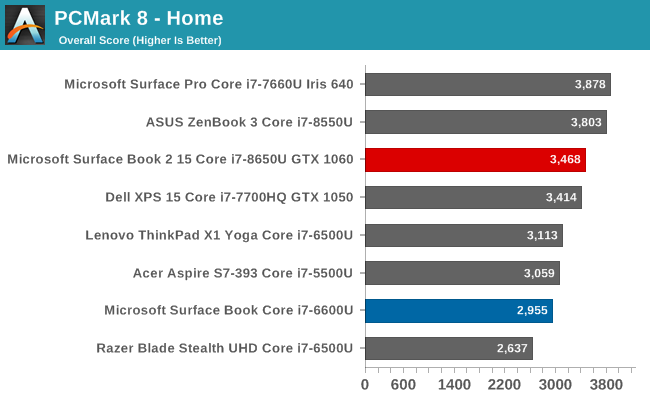
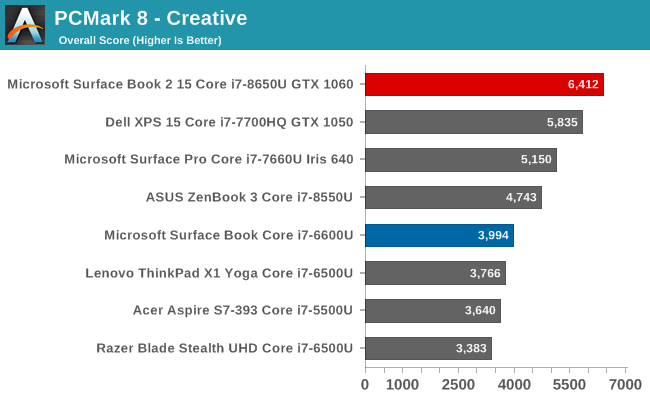
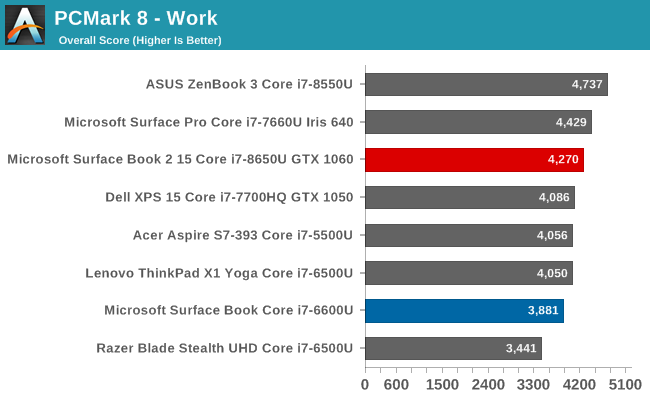
PCMark tests an entire system, from the CPU to the GPU to the storage, and all aspects of the device, including things like the display resolution, impact the results. The Surface Book 2 performs well on all of the tests, and it’s unsurprising to see it at the top for Creative, which has several GPU focused tests.
Cinebench
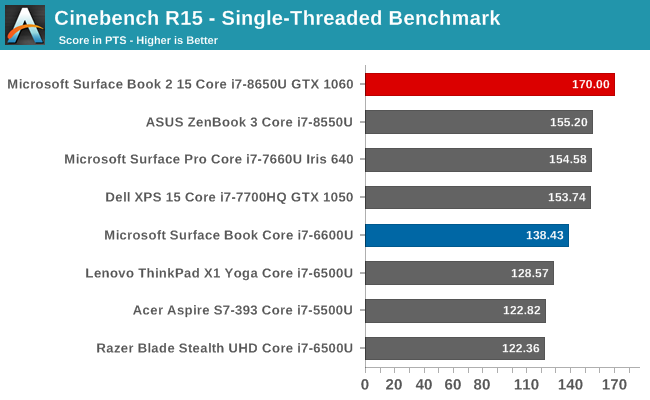
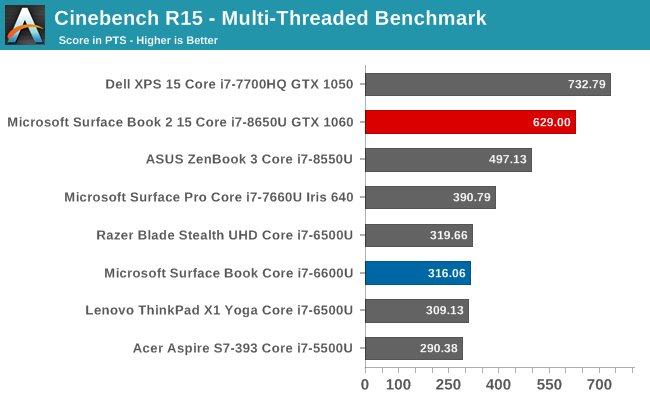
Cinebench is a rendering test which can use OpenCL, a single CPU thread, or all CPU threads to render the image. Our test focuses on the two CPU tests, and it gives us a great look at per-thread performance, and how that scales with more cores. Here the high turbo frequency of the Core i7-8650U delivers excellent single-threaded performance, and the multi-core result is also very strong. It can’t quite hang with XPS 15, but that has a 45-Watt TDP on its eight threads, allowing them to maintain a much higher turbo for the multithreaded result.
x264


Much like Cinebench, the x264 test converts a video using the CPU, and more cores with higher frequency generally wins the day here. The Surface Book 2 outperforms all other laptops with the 15-Watt TDP U series CPU in this test, but the higher TDP XPS 15 can still outperform it significantly when all cores are utilized.
Web Tests
The web is one of the most-used tools around, but performance on the web can be tied to the CPU as well as the browser itself. Over time, scripting performance in the browser continues to improve, and which browser you use will also impact performance and battery life. To make everything consistent, we utilize Microsoft Edge for all testing on Windows.
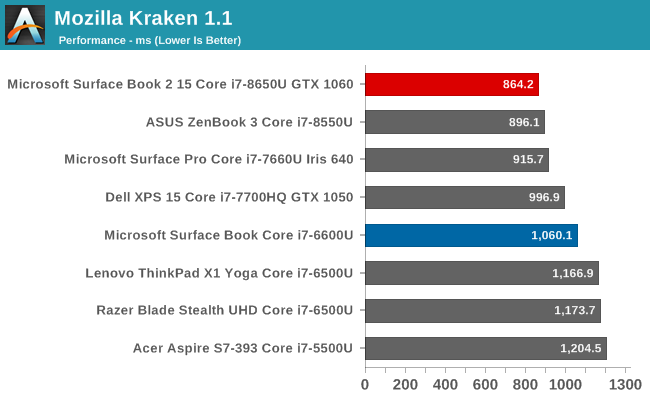
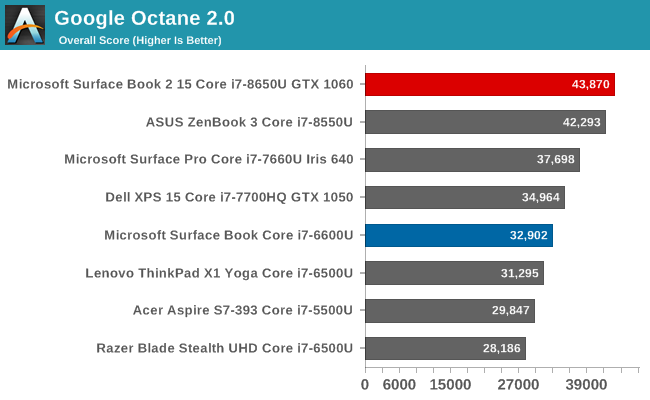
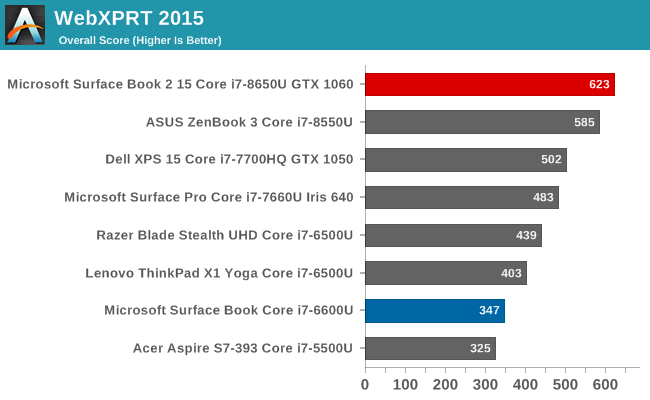
The Surface Book 2 has a slight CPU advantage over the ASUS ZenBook 3, and with that edge it creeps ahead in all of the web tests. The extra cores, as well as the updates to the browser with the Fall Creators Update, have made a significant difference over the older results. It would be nice to go back on some of these older devices to see how much of an impact the browser updates have made, if we still had the devices.
CPU Conclusion
As we saw with the ASUS ZenBook 3, the move to quad-core in the U series of Core chips has been very welcome. The performance increase is impressive over the older dual-core models, and although the eight threads run into the thermal limit quicker than the do on the higher-wattage HQ series chips, such as seen in the Dell XPS 15, the Core i7-8650U is still a very strong performer.
Storage Performance
The review unit for the Surface Book 2 shipped with the maximum drive size available, which is the 1 TB model. Thanks to the parallel nature of SSDs, this model should offer the best performance. The drive in the unit is a Samsumg PM961, which is a TLC based drive.
Performance is excellent for a TLC drive, and we do see the sequential write being affected by the TLC NAND, but all other aspects of the performance are excellent. In a device hitting this price target, a MLC version of this drive would be preferable, but it’s unlikely most people will notice the limits of this drive because it is quite good.


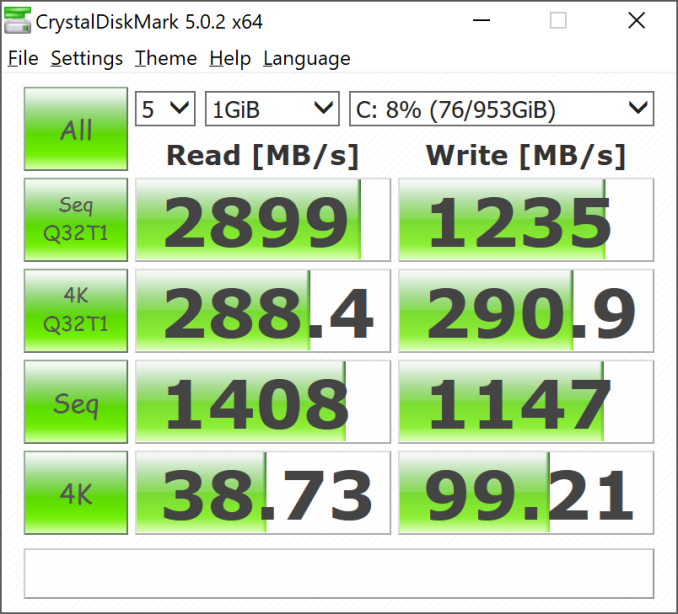








120 Comments
View All Comments
Brett Howse - Saturday, December 23, 2017 - link
If one of the scores is an outlier we throw it out and take the highest of the rest.binary dissonance - Friday, December 22, 2017 - link
I wonder if the reason an external thunderbolt isn't offered is that they decided to use that to interface with the GPU in the keyboard. (Or surface connect uses enough PCIE lanes that offering thunderbolt isn't an option.) A PCIe bottleneck might limit 1060 GPU performance along with power throttling.Speednet - Saturday, December 23, 2017 - link
I believe much a the reasoning is because of the connection between the tablet and the main unit. I read a while back that it uses PCI lanes that otherwise would go to the TB3 connection.Speednet - Saturday, December 23, 2017 - link
I upgraded from SB1 to SB2 (15", 1TB) when they first came out, so I've had some time to live with the new model. And it is a fantastic machine! I do mainly development (coding) and graphics work, and it is just perfect for both of those activities. The 15" screen with 3:2 aspect ratio is so good that I would not even consider a standard 16:9 ratio screen at this point. It is a non-starter.Unlike what many people have said in reviews -- that the tablet part is "too big" -- I disagree. It is perfect for browsing the web or catching up on news feeds while lounging. On a small tablet my news reader feels cramped, but on the 15" screen I get all my sidebars and big reading area. (I use Nextgen Reader.)
My existing Surface Dock worked perfectly with the SB2.
I see some people go on & on about the lack of TB3, but I personally have no use for it at all. I suppose it would a great to have, just to say it's there in case I need it for some reason, but the reality is that I don't. With all the computer equipment I have, I don't think I have even a single TB3 device. It's a total non-issue.
I was glad to see this review give the heavy gaming/battery issue just about the right amount of weight. It's something to be aware of, but is something that most people will never experience in their lifetime of ownership. The Verge, on the other hand, acted as if the sky were falling.
Who would have guessed 10 years ago that Microsoft would be making the industry's best computer hardware?
grant3 - Wednesday, December 27, 2017 - link
As you said: "I have an existing dock" which doesn't apply to the rest of us unwashed masses who don't already own a surface.
Maybe we have an existing tbolt dock we use with our Dell. Or maybe we want to get a dock which we hope to reuse with our next laptop without locking into the "Surface" ecosystem. Or maybe we just like the aesthetics of keeping a single USB cord out on the desk instead of a boxy dock.
We're about 2.5 years into the life of tbolt-over-usb-C as an industry standard, and *STILL* Microsoft can't get its act together to offer it on their flagship product? Common now, that's just ridiculous. Totally inexcusable.
damianrobertjones - Thursday, October 11, 2018 - link
...and still we have mega-cheap docks that suck and often break. Let alone the cable lottery from Amazon.Lolimaster - Sunday, December 31, 2017 - link
You should thank AMD that made dual cores obsolete with the arrival of Ryzen. Now get a Threaripper.prateekprakash - Monday, December 25, 2017 - link
Hi,I was wondering, could one play uhd Netflix on this device, or does it have lower res than 3840 so it would not meet the uhd specs?
milkod2001 - Thursday, December 28, 2017 - link
On such small screen you will never notice so yeah, it would play 4k videos just finesonicmerlin - Monday, December 25, 2017 - link
Why don't they just make a GPU base for the Surface Pro...?